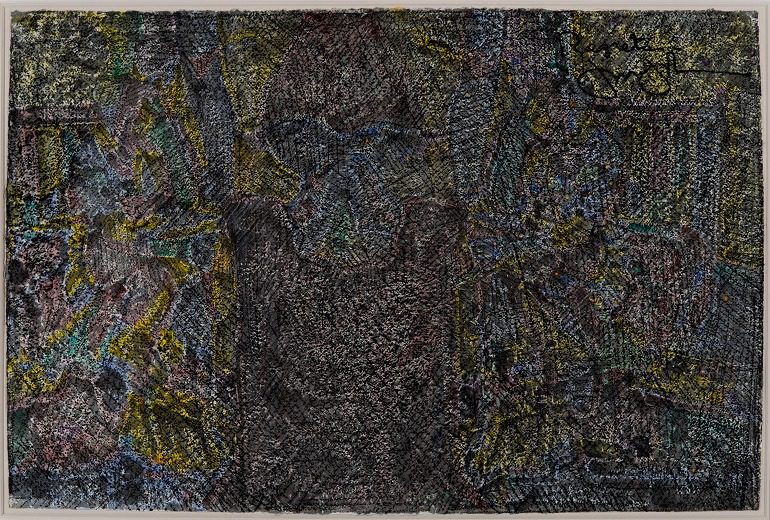ART & DESIGN
Jasper Johns (American, born 1930). Study for Regrets. 2012. Acrylic, photocopy collage, colored pencil, ink, and watercolor on paper.11 3/8 × 17 3/4″ (28.9 × 45.1 cm). Art © Jasper Johns/Licensed by VAGA, New York, NY. Photograph: Jerry Thompson. Image courtesy of Museum of Modern Art
ART REVIEW
BY KAZAD
Jasper Johns: Regrets, at the Museum of Modern Art celebrates an American artist who made a name for himself using iconic images like Target, the American Flag, and Numbers.

NEW YORK, NY—Whenever the name Jasper Johns is mentioned, what comes to mind is the American flag. In 1954, Johns created an art piece using the American flag, and this has become a major marker in his artistic career. Titled Flag, the artwork is now in the collection of the Museum of Modern Art. Through the years, the flag has become both iconic and a signifier for Johns.
Jasper Jones Flag
But the American flag is not the only iconic motif Jasper Johns painted: He also did targets and numbers. Although these iconic images have come to define Johns artistic career, there is no doubt that he is a versatile artist.
Johns’s resourcefulness is the focus of a new exhibition at the Museum of Modern Art in New York. Titled Jasper Johns: Regrets, the exhibition presents a new series of works created over the last year and a half by this famous American artist. The series includes drawings, paintings, and prints.
Johns’s new works were inspired by a photograph of Lucian Freud. It is part of a series taken around 1964 by the British photographer John Deakin. Deakin was commissioned by Francis Bacon who used the photographs as source material for his own paintings. From this series, Johns selected the image of the young Freud perched on a bed with one arm raised to obscure his face in an introspective gesture.
In creating his new works, Johns explored not just the image of Freud but also the physical qualities of the original black-and-white print. The print had been thoroughly degraded through extensive use. Furthermore, It was creased and torn by Bacon in the course of his studio practice.
Jasper Johns: Regrets was organized by Christophe Cherix, The Robert Lehman Foundation Chief Curator of Drawings and Prints, and Ann Temkin, The Marie-Josée and Henry Kravis Chief Curator of Painting and Sculpture, with Ingrid Langston, Curatorial Assistant, Department of Drawings and Prints, MoMA. The show takes viewers through the mind and thinking of the artists as he explored Freud’s image and photograph.
Creative Struggle
A series of small pencil sketches, a set of four ink-on-plastic drawings, and two prints reveal Johns’s creative process. They illuminate the struggle of the artist as he tries to actualize his probe of Freud’s innermost thoughts. The cumulative result of that unending experimental tussle is evident in a large-scale watercolor painting titled Regrets. So much of Johns’s thoughts and internal creative conflicts are encapsulated in this watercolor piece that obscures the image of Freud to the point of abstraction.
Regrets, the title of Johns new exhibition came from a stamp he produced about five years ago. The stamp enabled him to swiftly decline the stream of requests and invitations that he frequently received. Instead of writing a long letter explaining why he could not attend an event, the stamp sufficed. The word “Regret” appears prominently on two of the paintings in this show. Enlarged as a screen print, the word appears on the right corner of two paintings, where they serve as the title of the painting as well as the artist’s signature.
The word “Regret” as explored by Johns presents multiple interpretations. On one hand, the word references Freud’s contemplative mood. Sitting on a bed with one arm obscuring his face in an introspective gesture, Freud’s body language suggests he is regretting an action or event. On the other hand, however, it seems Johns is the one regretting his inability to accurately capture Freud’s mood or even his physical gesture because the photograph had been utterly degraded due to multiple uses. Perhaps that is why there is a dominant dark form in the center foreground in the series.
Jasper Johns Perfect Picture
Located in the Paul J. Sachs Drawings Galleries, this new series reveals Johns’s internal conflict as he struggled to create a perfect picture. From his exploration of materials and media, there is a revelation of the importance of process and experimentation, and of failing and starting again. This resilience and extraordinary technical ability are evidently what has made Johns one of the most celebrated American artists.
From his exploration of materials and media, there is a revelation of the importance of process and experimentation, and of failing and starting again.
New Works in Jasper Johns: Regrets



Jasper Johns: Regrets, on view through September 1, 2014, at the Museum of Modern Art, 11 West 53 Street, New York, NY 10019
